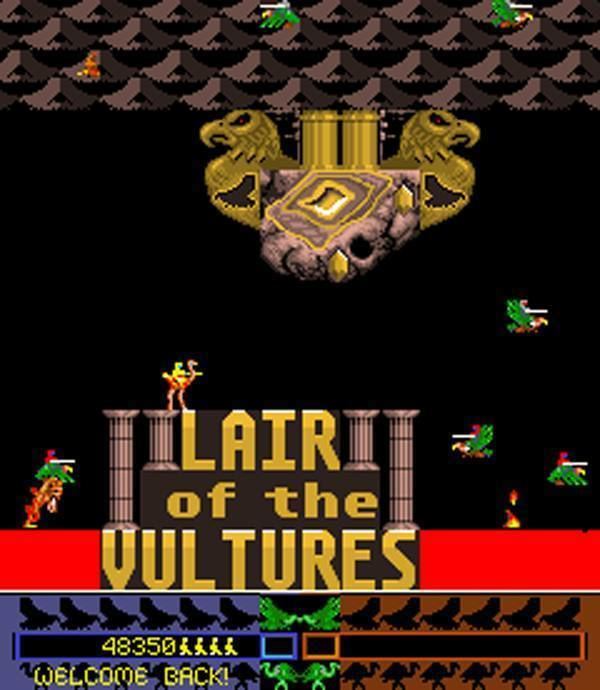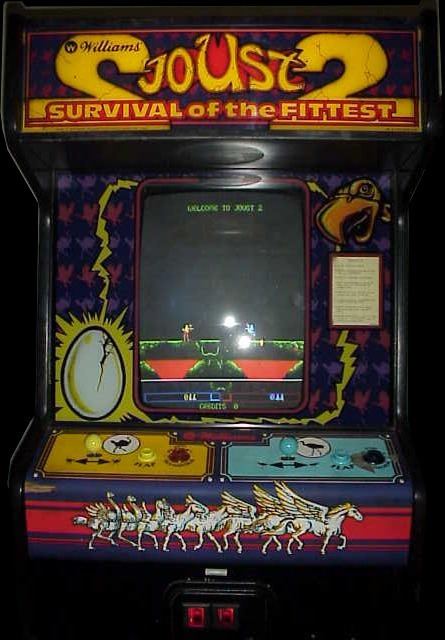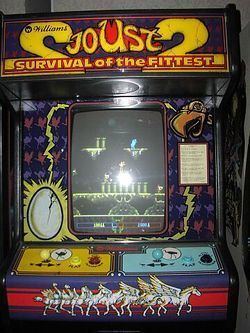Cabinet Upright Developer WMS Industries Publisher WMS Industries | Mode(s) 2 players Initial release date December 1986 | |
 | ||
Programmer(s) Joe Hellensen, Kristina Donofrio, Warren Davis Artist(s) John Newcomer, Jack Haeger (graphics)Tim Elliott (cabinet) Arcade system Williams Rev. 2CPU: M6809 (@ 1 MHz)Sound CPU: M6808 (@ 1 MHz), M6809 (@ 2 MHz)Sound Chips: Yamaha YM2151 FM, MC1408 DAC, Harris HC55536 CVSD Similar WMS Industries games, Platform games | ||
Classic game room joust 2 survival of the fittest arcade machine review
Joust 2: Survival of the Fittest is an arcade game developed by Williams Electronics and released in 1986. It is a sequel to Williams' 1982 game Joust. Like its predecessor, Joust 2 is a platform game that features two-dimensional (2D) graphics. The player uses a button and joystick to control a knight riding a flying ostrich. The object is to progress through levels by defeating groups of enemy knights riding buzzards. Joust 2 features improved audio-visuals and gameplay elements absent from the original.
Contents
- Classic game room joust 2 survival of the fittest arcade machine review
- Joust 2 arcade game
- Gameplay
- Development
- Reception and legacy
- References

The game uses more advanced hardware than the original Joust, allowing for the new elements. John Newcomer led development again, which began to create a conversion kit that allowed arcade owners to convert the cabinet into another game. Williams chose a vertically oriented screen for the kit as a result of the design's popularity at the time. Released during the waning days of the golden age of arcade games, Joust 2 did not achieve the success that Joust reached. The game was later released on home consoles as part of arcade compilations.

Joust 2 arcade game
Gameplay

Joust 2 is a platforming game like its predecessor, Joust, in which the player controls a yellow knight riding a flying ostrich from a third-person perspective. The player navigates the protagonist around the game world, which consists of floating platforms, via two-way joystick and a button. The joystick controls the horizontal direction that the knight travels, while pressing the button makes the ostrich flap its wings. The rate at which the player repeatedly presses the button causes the ostrich to fly upward, hover, or slowly descend. The objective is to defeat groups of enemy knights riding buzzards that populate each level, referred to as a wave. Upon completing a wave, a more challenging one will begin.

Players navigate the knight to collide with enemies. The elevation of an enemy in relation to the player's knight determines the outcome of the collision. If the protagonist is higher than the enemy, the villain is defeated and vice versa. A collision of equal elevations results in the two knights bouncing off each other. Joust 2 introduced a transformation ability that morphs the player's bird into a pegasus, which provides better offensive capabilities while on ground but poor flight capabilities. A second player can join the game. The two players can either cooperatively complete the waves or attack each other while competitively defeating enemies.
Development

Joust 2 was developed by Williams Electronics, with John Newcomer as the lead designer. The game features amplified monaural sound and raster graphics on a 19-inch color CRT monitor. Like other Williams arcade games, Joust 2 was programmed in assembly language. Williams' video game department had shrunk following a decline in the video game industry. The company wanted to sell an arcade conversion kit for games that use a vertically oriented monitor, which had become popular at the time. Management felt that a sequel would improve the kit's saleability. The company decided to release a sequel to either Robotron: 2084 or Joust, ultimately choosing the latter. Technology had progressed since the original's release, providing more flexibility than before. As a result, Newcomer conceived new elements: additional characters, improved audio-visuals, and new mechanics. To portray a progression of villains, the staff added a new enemy, Knight Lord. The developers added backgrounds to the levels, inspired by artwork by M. C. Escher, Newcomer's favorite artist. Staff added a transform button to provide players with more variety and balance the gameplay.
Reception and legacy
Williams shipped around 1,000 units of Joust 2, significantly fewer than its predecessor. Brett Alan Weiss of Allgame and Mike Bevan of Retro Gamer attributed the poor numbers to an industry slump in the mid-1980s. Joust 2 arcade cabinets have since become fairly rare among collectors. Weiss negatively compared the game to its predecessor, calling Joust more popular and enjoyable. However, he commented that Joust 2's graphics are more detailed and robust. In retrospect, Newcomer expressed dissatisfaction with the game's design, specifically the monitor's orientation. He commented that the gameplay works best with a horizontal orientation or with multi-directional scrolling. The vertical orientation proved to be a hindrance for home conversion. The game saw fewer home releases than Joust. In 1997, it was released as part of Arcade's Greatest Hits: The Midway Collection 2. Joust 2 was also included in the 2003 and 2012 multi-platform compilations Midway Arcade Treasures and Midway Arcade Origins, respectively. It also appeared in 2016's Lego Dimensions.
